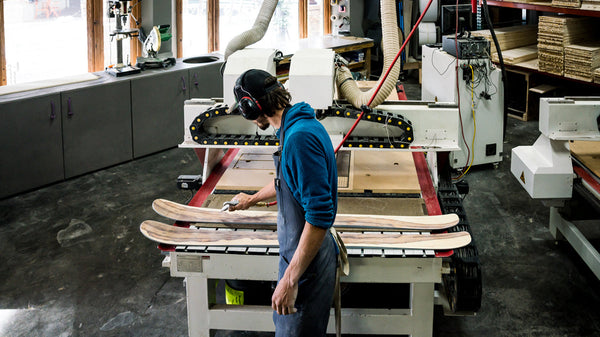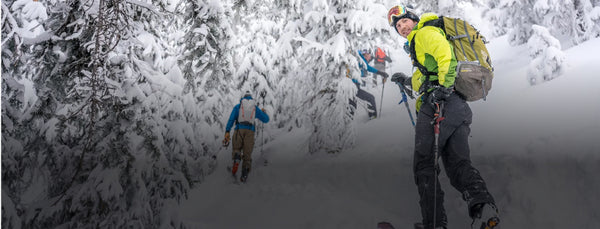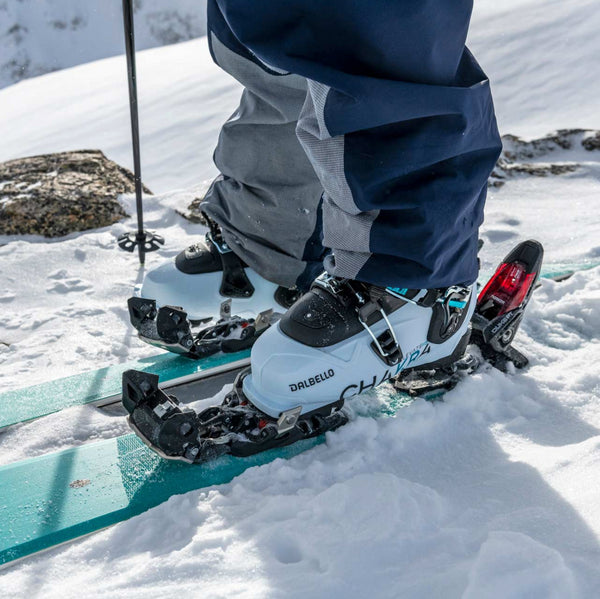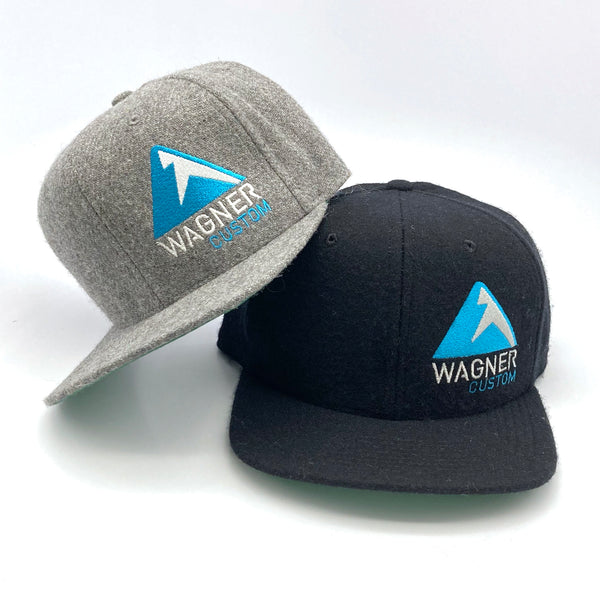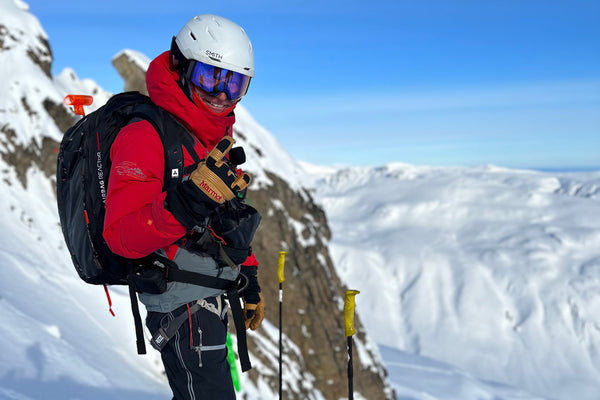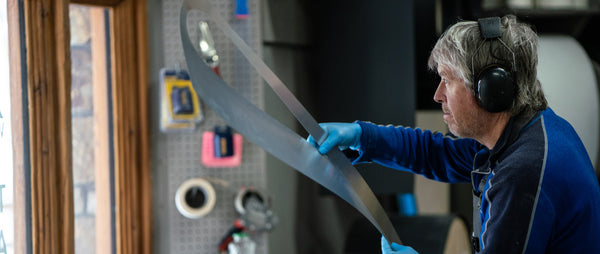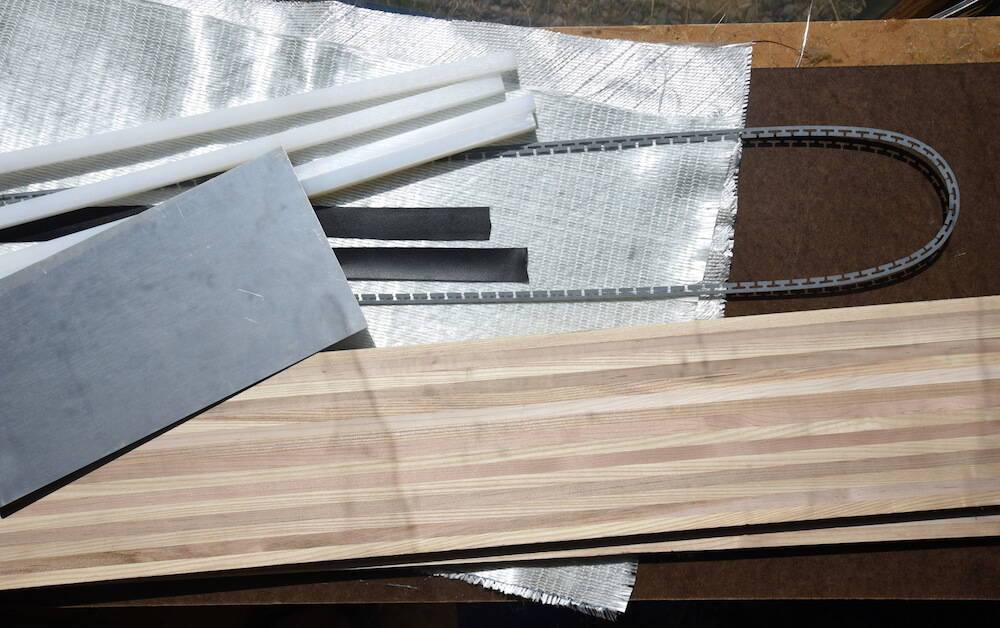
SKI BUYER'S GUIDE, PART 4: SKI MATERIALS
Sure, shape, profile, and length determine many attributes of a ski, but the materials are really the meat—and bread—of the proverbial sandwich.
They are the biggest determining factor for flex, feel, and personality.
We’ll explain here what each material does for a ski, but if you aren’t an engineer or a rocket scientist or think “torsional rigidity” is a term best-suited for another activity entirely, don’t worry—we’ve got you. We can discern what kind of skis you like from a simple interview, and we’ll tinker in our shop accordingly.

CORES
If you want to understand what goes into making skis, we need to start with the core. The core of a ski—combined with laminates, which we’ll get to in a minute—is largely responsible for the way your ski feels underfoot. The core is exactly what it sounds like: the center of the ski. In mass-market skis, it’s usually made of wood, foam, or plastic.
Foam cores are lightweight but aren’t durable. Plastics cores like honeycomb consist of air, so they chatter and have poor vibration damping characteristics. Wood cores, on the other hand, offer excellent rebound, are more responsive, damp vibration, have a lively feel, keep their shape well, and are extremely durable. Wood-core skis tend to feel more stable, too, and are less likely to degrade over time. At Wagner, we only craft skis with wood cores, because, well, they’re just the best.
Wood cores have various densities, depending on the type of wood used. High density cores, like hardwoods, are heavy and durable, which makes the ski drive better in variable conditions. Lower density cores, like poplar or paulownia, have a lighter feel and allow the ski to be more nimble.
To build the core, we layer vertical strips of wood—most often with varying densities—together and bond them with epoxy. This gives the ski its longitudinal stiffness.
STRUCTURAL LAYERS
A wood core is typically sandwiched between structural layers, which give the ski its torsional rigidity (stiffness while twisting) and can add vibration damping.
Common types of structural layers include fiberglass, Titanal (which is actually an aluminum alloy), carbon fiber, aramid, and rubber.
Structural layers made of metal (Titanal) generally give a ski a more stable, smooth, and powerful feel. Metal damps vibration, transmits power to the edges, and provides a more secure mounting platform. If you want your skis to be unflappable on bulletproof and plow through chunder, metal is the way to go. That said, it can also make a ski feel less lively and have less rebound, so it really depends on your preference.
Fiberglass is probably the most common ski laminate. It starts out as a cloth, but when soaked in epoxy, it becomes torsionally stiff and yet lighter than metal. Skis with fiberglass laminates run the gamut from light and lively to damp and stable—but not quite as damp and stable as those with metal in them.
Skis that have lighter structural materials, like carbon or aramid, will produce a more light and nimble feeling on snow, including quicker turning in tight terrain such as bumps, trees, and technical couloirs. Carbon is ultralight and therefore great for backcountry skis, but these very lightweight materials are not confidence-inspiring in challenging snow conditions or at speed.
A NOTE ON WEIGHT
Lightweight gear is a trend in the industry right now, and we urge caution on this if skiing uphill isn’t modus operandi. Downhill skiing is a gravity sport, so generally weight is not a bad thing. Having additional mass gives the skis the ability to hold an edge better and slice through variable snow. Then again, some feel the holy grail is getting a ski that is light enough to be nimble in tight terrain, but heavy enough to perform in variable and hard snow conditions.
For the uphill skinners, of course, light skis are a must. But on the downhill, lightweight skis tend to get deflected by terrain features such as bumps, hard snow, and chunder, and bounce around in most conditions.
Wagner will ensure the structural materials are perfect for the skiing you’ll be doing.
SIDEWALLS
The sidewall on a ski is the external wall of the ski between the base and topsheet. It seals and protects the wood core and structural layers from the elements and moisture. A sidewall adds damping, power transmission, and durability to the skis.
Some skis have a vertical sidewall that runs from the tip to the tail, which is called a sandwich construction. These skis are prized for their power transmission, edge-grip, and vibration damping. Others have a cap construction, where there is no sidewall and the topsheet of the ski runs all the way down to the steel edges. These skis are generally lighter and are less exposed to chipping on the topsheet, but don’t have as much power and edge-grip as a sandwich construction. Others have a semi-sidewall construction, which is a combination of the two described above.
BASES AND EDGES
Bases are the bottom layer of the ski that makes contact with the snow. Bases are typically made of P-Tex, which is essentially polyethylene, and are typically structured with micro-grooves—rather than mirror-smooth—to reduce suction and promote glide. There are various quality levels of P-Tex, some of which are optimized to be fast and some to be durable. All black bases have a higher carbon and graphite content, which makes them easier to repair and faster.
Steel edges wrap the base of the skis, and they come in various thicknesses. Race skis are often made with thin edges to reduce drag. Thicker edges, however, will be more durable. So if you tend to ski groomers and don’t get many scratches on your skis, thin edges will probably work fine for you. If you typically have to get base welds and tune your skis often, well, durability might be a priority.
TOPSHEETS
Topsheets are exactly what they sound like—the graphic layer on top of the ski that you see. The topsheet seals in the structural layers, protects the ski core and materials from moisture and UV rays, and adds a fun aesthetic.
Ski topsheets are typically made from nylon, which is scratch-resistant, durable, and can be screen printed or dyed. Wagner also makes topsheets with real wood veneers, which are finished with a clear coat material that gives the wood additional durability and UV stability.
For inspiration on what topsheet is right for you, check out Wagner’s graphics gallery here. We collaborate with awesome artists from around the globe to create the coolest topsheets on the planet. Naturally, we also do custom graphics, too—check these out to get your creative juices flowing.
As always, Wagner Custom is here for you. We’ll hand-craft your perfect pair of skis—guaranteed. Get started today and schedule a call with a ski designer.
Ready to learn more about ski design and what to look for when purchasing new skis? Take a look at these articles from our Ski Buyer’s Guide:

